Samsung Galaxy S 6 and S 6 Edge: Preview
by Joshua Ho on March 26, 2015 9:00 AM EST- Posted in
- Smartphones
- Samsung
- Mobile
- Galaxy S6
- Galaxy S6 Edge
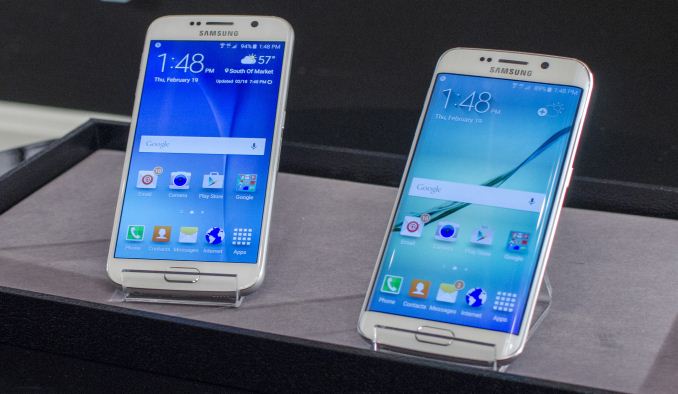
Yesterday we received our Galaxy S6 and S6 edge review units. We’re still working on the final review but I wanted to share some early results from both devices. For those that are unfamiliar with these two phones, the Galaxy S6 range represents the result of Samsung’s “Project Zero”. In fact, the phones seem to have the internal name of Zero, which can be seen in terminal, and the build properties of both devices. For Samsung, these phones represent their attempt at completely rethinking how Samsung makes phones. There is a strong emphasis on a new unibody design, which has no visible gaps or screws. Rather than the plastic that previous Samsung phones have been known for, the new design is composed of metal and glass. Samsung’s design team has been given unprecedented control throughout the process of making this phone and the result of this is a Galaxy phone that looks unlike anything else they’ve ever released.
Even if design is important, it isn’t enough to make the phone. Samsung has also outfitted the Galaxy S6 and S6 edge with their latest technologies, from a new AMOLED display to a new camera module. The specs for both phones can be seen below.
| Samsung Galaxy S5 | Samsung Galaxy S6 | Samsung Galaxy S6 Edge | |
| SoC | MSM8974ACv3 2.45 GHz Snapdragon 801 | Exynos 7420 2.1/1.5GHz A57/A53 | Exynos 7420 2.1/1.5GHz A57/A53 |
| RAM/NAND | 2GB LPDDR3 16/32GB NAND + microSD |
3GB LPDDR4-1552 32/64/128GB NAND |
3GB LPDDR4-1552 32/64/128GB NAND |
| Display | 5.1” 1080p SAMOLED HD |
5.1” 1440p SAMOLED |
5.1” 1440p SAMOLED, Dual Edge |
| Network | 2G / 3G / 4G LTE (Qualcomm MDM9x25 UE Category 4 LTE) | 2G / 3G / 4G LTE (Category 6 LTE) | 2G / 3G / 4G LTE (Category 6 LTE) |
| Dimensions | 142 x 72.5 x 8.1 mm, 145 grams | 143.4 x 70.5 x 6.8mm max, 138 grams | 142.1 x 70.1 x 7.0mm max, 132 grams |
| Camera | 16MP (5132 x 2988) Rear Facing with 1.12 µm pixels, 1/2.6" CMOS size, 31 mm (35mm effective), f/2.2 | 16MP (5132 x 2988) Rear Facing w/ OIS, f/1.9, object tracking AF | 16MP (5132 x 2988) Rear Facing w/ OIS, f/1.9, object tracking AF |
| 2MP Front Facing | 5MP Front Facing, f/1.9 | 5MP Front Facing, f/1.9 | |
| Battery | 2800 mAh (10.78 Whr) | 2550 mAh (9.81 Whr) | 2600 mAh (10.01 Whr) |
| OS | Android 4.4 w/TouchWiz |
Android 5 (64-bit) w/TouchWiz | Android 5 (64-bit) w/TouchWiz |
| Connectivity | 802.11a/b/g/n/ac 2x2 + BT 4.0 (BCM4354), USB3.0, GPS/GNSS, MHL, DLNA, NFC |
2x2 802.11a/b/g/n/ac + BT 4.1 (BCM4358), USB2.0, GPS/GNSS, NFC |
2x2 802.11a/b/g/n/ac + BT 4.1 (BCM4358), USB2.0, GPS/GNSS, NFC |
| Wireless Charging | N/A | WPC 1.1 (4.6W) & PMA 1.0 (4.2W) |
WPC 1.1 (4.6W) & PMA 1.0 (4.2W) |
| Fingerprint Sensor | Swipe | Touch | Touch |
| SIM Size | MicroSIM | NanoSIM | NanoSIM |
Both the Galaxy S6 and S6 edge have Samsung System LSI’s newest SoC, the Exynos 7420, which has a cluster of four Cortex A57s clocked at 2.1 GHz, and four Cortex A53s clocked at 1.5 GHz. Compared to the Exynos 5433 of the Galaxy Note 4, this brings a new 14nm LPE (low power early) process, an upgrade to LPDDR4 memory, and a Mali T760 GPU with two additional shader cores. Outside of the SoC, the new display is advertised to bring a higher 600-nit brightness and a higher 1440p resolution. The front and rear cameras are both different from the Galaxy S5 as well, although the rear camera sensor may be shared between the two as the camera sensors are of similar spec. For this preview, we’ll focus on the system performance and display of these new devices, but as one can see from the specification table there is far more to look at for the full review.
System Performance
For our system performance benchmarks we’ll start with our browser tests which can give a rough proxy for overall CPU performance.
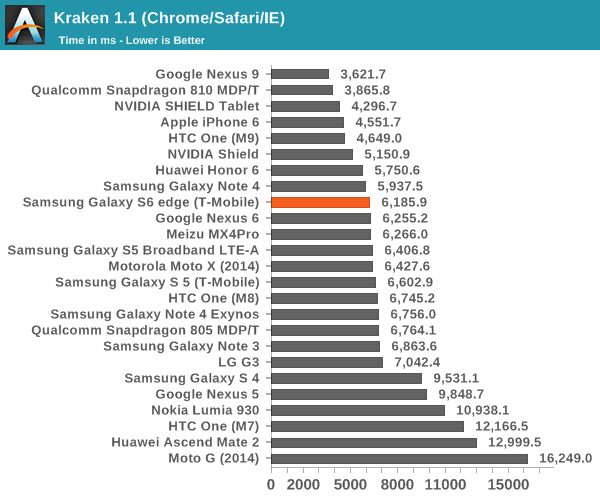
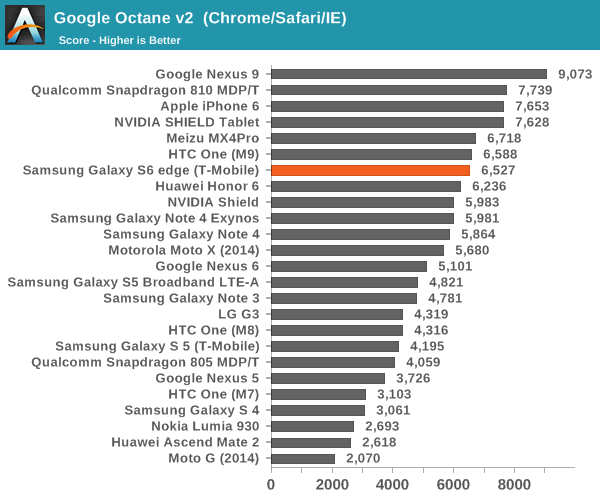
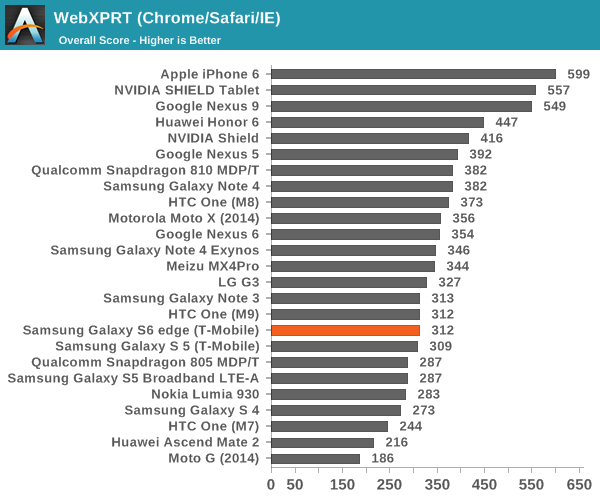
The Exynos 7420 is about on par with the Snapdragon 810 in these benchmarks. Strangely enough both tend to do worse than the Huawei Honor 6 in these tests, which clearly can't be correct. As we've previously discussed, the stock browser will often give far better results due to OEM and SoC vendor optimizations. As a part of our updates to the benchmark suite for 2015, we'll take a look at Basemark OS II 2.0, which should give a better picture of CPU performance in addition to overall device performance.
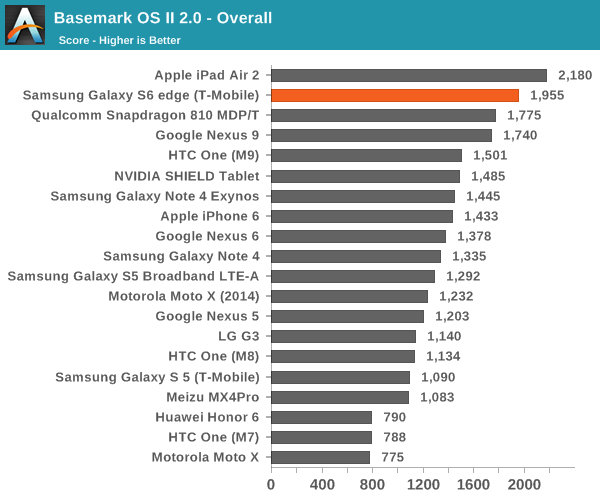
The browser benchmarks seem to hide some pretty enormous variability as the Galaxy S 6 edge (which is comparable to the Galaxy S 6) sets a new record among Android devices. The only challenger is the iPad Air 2, which uses the A8X SoC with three Enhanced Cyclone cores and the semi-custom GXA6850 GPU.
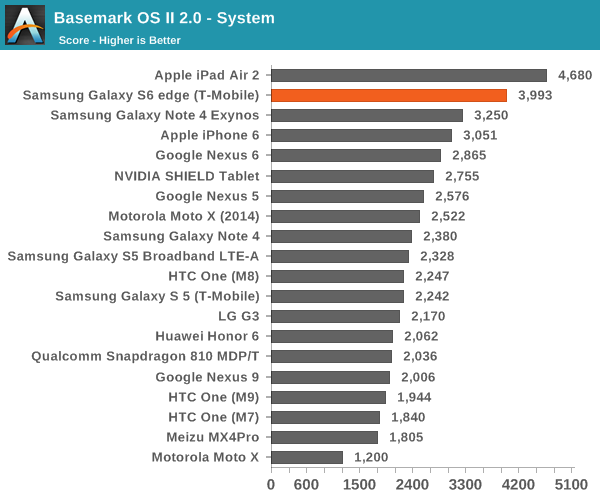
This system test contains a floating point and integer test, in addition XML parsing, which means that this test mostly stresses CPU and RAM. Interestingly enough, the Exynos 7420 pulls far ahead of both the Exynos 5433 and Snapdragon 810 in this test, and approaches the A8X. The difference between the 5433 and 7420 is likely a combination of the higher clocks on both the A57 and A53 clusters for the 7420 (1.9/1.3 on the 5433, 2.1/1.5 on the 7420), in addition to the ability to stay at a high 'overdrive' clock due to reduced leakage from the 14LPE process. The One M9 likely falls a bit short here due to HTC's governor settings restricting the use of all 8 cores simultaneously.
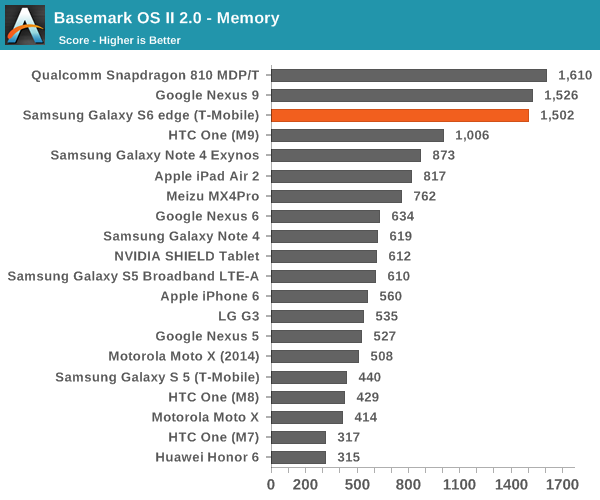
While one might guess that the memory test of 'Basemark OS II 2.0 - Memory' is of RAM, this is actually a test of the internal storage. Once again we see the S6 edge come close to leading the pack due to the use of the new UFS (Universal Flash Storage) standard. Casual examination reveals that the S6 edge has a queue depth of 16, and that it identifies itself with the rather cryptic model name of KLUBG4G1BD-E0B1.
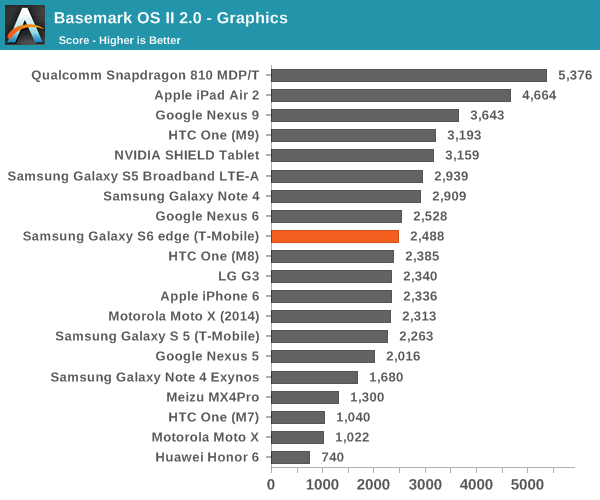
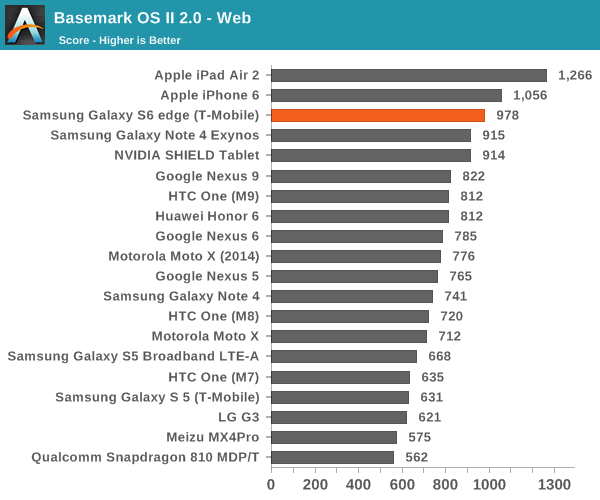
For the web test, it uses the built-in WebView rendering engine rather than Chrome and paints a distinctly different picture, especially because these tests are focused on HTML5 and CSS rather than JavaScript. Here we can see that the iPhone 6 and iPad Air 2 continue to hold their lead, but the Galaxy S6 is pretty much the king of the hill when it comes to Android devices.










200 Comments
View All Comments
steven75 - Friday, March 27, 2015 - link
Apple Pay uses NFC too. ;)Most of the world is already on chip and PIN and the US is moving to that this year. Magnetic strips is targeting the past.
hrrmph - Friday, March 27, 2015 - link
"...They decided to rip off the iPhone 6 in both design and features..."Exactly. Samsung had a superior functionality product - even it it was wrapped in high-quality plastic. Now they have downgraded themselves to making an iPhone.
Just like Apple, Samsung is now killing off functionality. All in a quest to make jewelry instead of computing machines.
Instead of getting 128GB hardwired and 200GB expandable = 328GB storage (plus future upgrades beyond 512GB) we are stuck at 32, 64, or 128... just like iPhone.
Instead of being able to justify buying at the high-end of the market and then keeping a device in great condition for the long-term by occasionally popping in a fresh new battery, we are stuck tossing the device away... or sending it off to a hack shop for a dodgy "service center" battery replacement... just like an iPhone.
Samsung is being unusually quiet about how many and which LTE bands they will support. So I'm guessing that out of the 44 LTE bands available worldwide, Samsung is in no position to give us a world-phone that will work on every continent... just like an iPhone...
(but watch out next year though when Apple implements the new 29 LTE band Intel modem chip that *should* be enough to cover all bands currently in use on all continents)
So let's face it... Samsung shat themselves here. There is no long term investment to be made in an S6. Samsung has downgraded us to buying an iPhone knock-off.
And the iPhone is gradually improving. Maybe in another generation or two, the iPhone could surpass the S5 Duos in functionality. Apple only needs to add a removable battery, a Micro-SD slot, and a 2nd SIM slot.
With Samsung hellbent on making iPhones, the only upgrade path from the Galaxy S4 now *IS* to the Galaxy S5. Forget the S6.
ama3654 - Thursday, March 26, 2015 - link
Please use Stock browsers next time, OEM's don't have optimization on chrome. Or use chrome for iOS devices as well. ThanksAzurael - Thursday, March 26, 2015 - link
Stock browsers give another venue for OEMs to cheat, not the best idea... And Chrome has hamstrung Javascript performance on iOS, so no good there. You'll have to live with it!Drumsticks - Thursday, March 26, 2015 - link
So far the S6 seems to have come through with everything we figured it would.Better performance than the 810, Great display, better materials. To me, The MicroSD and the removable battery aren't huge, but I AM worried about the smaller battery size overall. Battery will be the most important test for this device, so we'll have to see just how well it does. Presumably, it could make or break it just like the Camera (in a way) makes or breaks the One M9.
If I can get a solid day and then some (to handle battery decaying later on to get a full day in a year), with the rapid charge and all that it all brings, I think I'll be happy. Samsung Pay as well seems pretty interesting.
Overall, Android has gotten interesting enough to make me think about coming back. I had a Lumia for the last two years and was actually perfectly happy with it, but I like bouncing back and forth between Android and WP. I've used an iPhone 5 the last 3 months or so because of switching to AT&T (928 doesn't work there), but I haven't been very impressed. At this point, I'm just waiting on some reviews of the S6 that I trust (namely Anandtech and Ars), and possibly waiting to see what the G4 has to bring to the table. Unfortunately, unless something huge changes, I think I'm skipping the One M9; there are just too many side steps to consider to me.
Shadowmaster625 - Thursday, March 26, 2015 - link
I do not understand. For what purpose or for what app is a 1080p display not adequate? Even if using multi-window multitasking, is it really that important? Multi-window multitasking will drain a battery twice as fast, so do you really want the added drain of such a ridiculous display?darkich - Thursday, March 26, 2015 - link
Well, Samsung’s virtual reality headset is the only good reason I can think oflilmoe - Thursday, March 26, 2015 - link
I really wished they stuck with 1080p... But Samsung is a business; they're trying to compete in the spec sheet AND they're trying to create a new market with VR.At least give the non-resolution-happy crowd like me an option to lower the res back to 720p (1:1 vs 1440p). 8-12 subpixels per pixel would be nice on that display (and the Note 4's).
SydneyBlue120d - Thursday, March 26, 2015 - link
In the final review I ask You to dig as deep as possible about the Samsung (or Intel?) modem used especially against HTC One M9 (e.g. take a look at this article http://goo.gl/TwDMkm ), audio quality and HEVC encoding/decoding support (if it will be added in the future or if the SOC doesn't support it). Thanks a lot.Andrei Frumusanu - Thursday, March 26, 2015 - link
The SoC has HEVC encoder and decoders but Samsung again doesn't expose it to the OS.